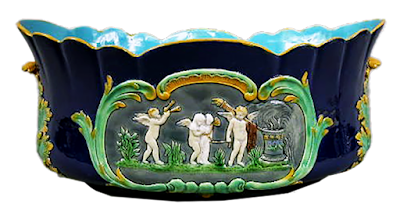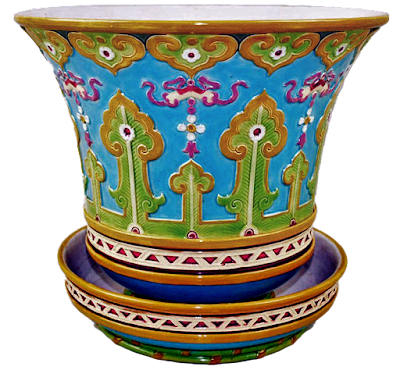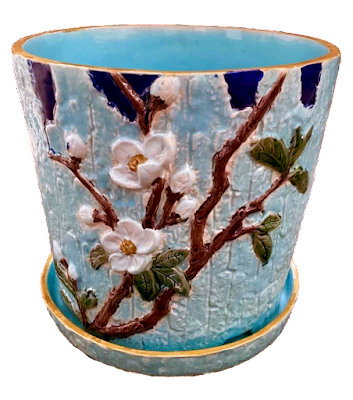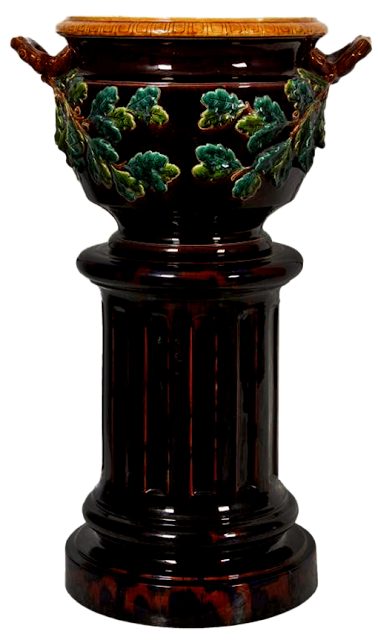From Wikipedia: Jardinière is a French word, from the feminine form of "gardener"; A flower box, a receptacle (usually a ceramic pot or urn) or more rarely a stand upon which, or into which, plants may be placed. (The French themselves refer to tabletop versions of such receptacles as cachepots.) Jardinières tend to be highly decorative and are sometimes used as garden accent elements for large plants and for raised culinary and herb gardens.
The history of majolica jardinières and cachepots goes back to the origin of the pottery itself. There are probably more majolica designs for jardinières than any other majolica form. Majolica was ideal for use in solariums and greenhouses. Its use has continued many years after majolica has ceased to be popular for other uses. Even today you can go into Walmart or Home Depot and buy a flower pot in the contemporary equivalent of a majolica ceramic glaze.
Lets take a look at some Victorian examples:
From Minton...
This post has been updated since it was first published.
The history of majolica jardinières and cachepots goes back to the origin of the pottery itself. There are probably more majolica designs for jardinières than any other majolica form. Majolica was ideal for use in solariums and greenhouses. Its use has continued many years after majolica has ceased to be popular for other uses. Even today you can go into Walmart or Home Depot and buy a flower pot in the contemporary equivalent of a majolica ceramic glaze.
Lets take a look at some Victorian examples:
From Minton...
Tole and majolica tile jardiniere attributed to Minton
Image from the Minton pattern books
Minton majolica jardiniere designed by architect Gottfried Semper
Minton majolica jardiniere designed by Christopher Dresser
From George Jones...
George Jones majolica Stephanotis oval flower pot
George Jones majolica Stephanotis round flower pot
Made by both George Jones and Holdcroft
The Massier brothers...
Wedgwood..
Wedgwood majolica Luther jardiniere
Wedgwood majolica Old English jardiniere
Wedgwood majolica Lowell jardiniere
For Wedgwood by Christopher Dresser
Wedgwood Kate Greenaway jardiniere
Wedgwood Grosvenor jardiniere
Wedgwood majolica Fan jardiniere
Forester, Holdcroft, Dressler and Adams & Co....
| Forester Forester Forester Forester Forester |
Holdcroft
| Holdcroft Holdcroft Holdcroft Holdcroft Holdcroft Holdcroft Holdcroft Holdcroft |
Holdcroft
Holdcroft |
| Julius Dressler Julius Dressler Adams & Company Adams & BromleyAdams & Bromley |
Schiller, Copeland, Lonitz, Deck, Royal Art Pottery, and Brown, Westhead Moore...
Copeland
Copeland
Copeland Copeland Copeland |
Royal Dux…
Onnaing, Orchies and Sarreguemines...
Onnaing
Onnaing
Onnaing
Onnaing
Onnaing
Orchies
Sarreguemines
Sarreguemines
Sarreguemines
... and Griffen Smith & Company.
There are so many more designs that we couldn't possibly post them all. Still, this gives an idea of the width and breadth of the patterns produced as jardinières.
This post has been updated since it was first published.
















































































































































Wow, I kept scrolling down, thinking there was no way I could be more impressed, and was proven wrong after every picture!
ReplyDeleteWould you be able to tell me anything about what I have here, it's value and history? http://imgur.com/a/cbfSJ
I bought it this morning for a dollar. Someone on reddit said it was majolica, probably Austrian, and from the late 1800s, which is very helpful, but they didn't reply when I asked how they narrowed it down like that. Do those numbers on bottom mean anything about place or maker? Does the repair affect the value quite a bit? I mean, I paid a dollar, so I think I've gotten my money's worth. Haha. But I'm curious to find more of the story, if there is more. Thanks!
Your piece is 19th century majolica made by the Brothers Urbach. The company operated in Turin-Teplitz from 1882 to 1906. It was probably intended as a centerpiece.
DeleteCool! It's a nice satisfaction to know something about who and when. Thanks for taking a look. :)
DeleteIncredible things of beauty...The Lion Face/Paw Jardiniere under:Forester..Holdcroft..Dressler..Adams & Co..
ReplyDeleteWhich of those was it made by? I have a similar Thanks
I assume you are referring to the pink jardiniere with green decoration. That was made by Julius Dressler.
Delete